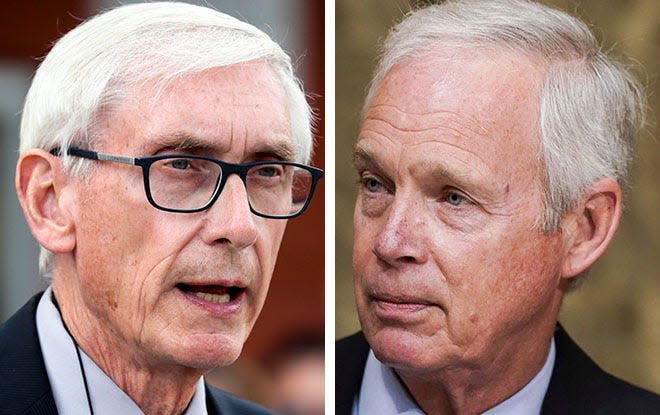Wisconsin's unusual split election was driven by some very familiar trends

Wisconsin’s two huge and consequential races for governor and U.S. Senate were won by different parties Tuesday.
But a now very familiar political pattern resurfaced in both.
Republicans continued to lose ground in the populous metro areas of Madison and Milwaukee.

And Democrats continued to slip in the state’s more rural northern and western halves.
The 2022 election saw a widening of the “density divide” as bigger cities and inner suburbs keep getting bluer and exurbs, small towns and the countryside keep getting redder.
In the governor’s race, this turned out to be a much bigger problem for Republicans than Democrats.
Incumbent Democrat Tony Evers defeated GOP challenger Tim Michels. His lead was a little more than 3 points and around 90,000 votes as of Wednesday afternoon — bigger than Evers’ 1.1-point victory over Republican Scott Walker four years ago.
Evers did that by improving his margins in the state’s most populous places, including Wisconsin’s biggest vote-producing counties: blue Milwaukee and Dane (home to Madison), red Waukesha and purple Brown (home to Green Bay) and Outagamie (Appleton).
In the Senate race, GOP incumbent Ron Johnson saw his margins in these same counties deteriorate but hung on to win a closer-than-expected victory over Democratic challenger Mandela Barnes. His lead as of Wednesday afternoon was around 1 point and less than 30,000 votes.
In both races, the GOP increased its dominance in the state’s smaller counties, reflecting a deeper Democratic decline in rural Wisconsin.
But elections are a numbers game and Republican slippage in key urban and suburban areas with lots of voters — a hallmark of the Donald Trump era — is daunting for the party.
In the suburban GOP county of Waukesha, for example, Republicans won for governor by around 46,000 votes, compared to an edge of almost 75,000 votes in the 2018 race for governor and almost 93,000 votes in the 2014 race for governor. That’s a decline from 2018 of almost 30,000 votes in the GOP margin – the biggest single vote shift in any Wisconsin county. In the Senate race, Johnson’s margin in Waukesha declined from about 38 points when he was last on the ballot in 2016 to around 25 this time.
Thanks to suburban inroads, Democrats won the 10-county Milwaukee media market for the first time in a governor’s race in 40 years.
The 2022 election made some notable history.
Subject to final official results, this appears to be the closest pair of Senate and gubernatorial races on the same ballot in Wisconsin history (dating back to 1914 when senators began to be popularly elected).
More:Tight elections feel normal in Wisconsin. Here is what makes this one so unusual
It stands right now as the closest Senate race in the state since that 1914 contest, which was decided by less than half a point.
It is the first time since 1990 that the party of the sitting president won the governor’s race in Wisconsin. The last time that happened with a Democrat in the White House was 1962.
While President Joe Biden suffered negative job ratings in Wisconsin, that wasn’t fatal to Evers. Remarkably, Evers won a bigger victory with a Democrat in the White House (Biden) than he did four years ago with a Republican in the White House (Trump).
This is also the first time since 1998 that Wisconsin has seen a split outcome at the top of the ticket, where the state voted one way for U.S. Senate and the other way for president or governor. That reflects the absence of a partisan “wave” in this midterm. It also reflects the state’s roughly 50/50 partisan makeup, which gives neither party — even incumbents — much room for error.
But the 2022 election was also a story about continuity, with incumbents prevailing in the two biggest races and with the dramatic regional voting shifts of the past decade continuing with force.
Dane County, home to Madison, continued to generate ever bigger Democratic margins, as it grows in population and its major city and virtually all of its suburbs turn deeper and deeper blue.
Evers won Dane 79% to 21% this time — a margin of 58 points. In 2018, Evers won just under 75% of the Dane vote and enjoyed a margin of 51 points.
The longtime trend is striking: Democrats won Dane by about 81,000 votes for governor in 2010, around 102,000 in 2014, almost 151,000 in 2018 and more than 174,000 on Tuesday. After Waukesha, Dane was the biggest single contributor to the growth in Evers’ victory margin from 2018 to 2022.
In the city of Milwaukee, turnout was down significantly from 2018, but Evers won Milwaukee County as a whole by a bigger raw vote margin in 2022 (at least 148,000 votes) than he did in 2018 (about 138,000). That’s because his share of the Milwaukee County vote increased from around 67% to around 71%, and his margins in many inner suburbs grew.
In the Senate race, Republican Johnson’s deficit in Milwaukee County grew, going from just under 30 points in 2016 to just under 40 points in 2022.
Even more importantly, Democrats reduced their losing margins in the traditionally red WOW counties of Waukesha, Ozaukee and Washington, filled with suburban and exurban communities on the periphery of Milwaukee County.
Evers lost Waukesha by almost 34 points in 2018 but that deficit went down to about 20 points in 2022. His deficit in Ozaukee County went from 27 points in 2018 to 11 points this time. Because of the decline in GOP margins, the combined WOW counties saw a shift from 2018 to 2022 of more than 40,000 votes in a Democratic direction.
In the Senate race, Johnson’s winning margins went from around 35 points in the combined WOW Counties in 2016 to roughly 23 points in 2022. Upscale Ozaukee County, a few decades ago the most Republican County in Wisconsin, was the 45th most Republican County (out of 72) in this governor’s race, carried by the GOP by a little over 10 points.
And in the relatively purple Fox Valley, another population center, the GOP also lost some ground. Republicans won Brown County by 8.4 points for governor in 2018, but by less than 5 points this time. They won Outagamie by 10.9 in 2018, but around 7 this time. Johnson’s margins also declined in these counties.
All in all, from 2018 to 2022, Evers’ improved his percentage of the vote in the five Wisconsin counties with the most votes (Milwaukee, Dane, Waukesha, Brown, Outagamie) and in 12 of the 15 biggest counties. Racine and Kenosha counties were among the exceptions.
At the same time, Democrats continued to lose ground in smaller counties.
While Johnson won his 2022 race by a much smaller amount than he did in 2016, he actually improved his share of the vote in a majority of Wisconsin counties. His margins grew by double digits in more than 20 counties.
It’s just that Johnson’s gains in lots of smaller counties were outweighed by his losses in a handful of big counties, leading to a much narrower victory than his 2016 win. The same pattern applied to the governor’s race as well.

Craig Gilbert provides Wisconsin political analysis as a fellow with Marquette University Law School's Lubar Center for Public Policy Research and Civic Education. Prior to the fellowship, Gilbert reported on politics for 35 years at the Journal Sentinel, the last 25 in its Washington Bureau. His column continues that independent reporting tradition and goes through the established Journal Sentinel editing process.
Follow him on Twitter: @Wisvoter.
This article originally appeared on Milwaukee Journal Sentinel: Wisconsin's unusual split election was driven by familiar trends
Solve the daily Crossword

